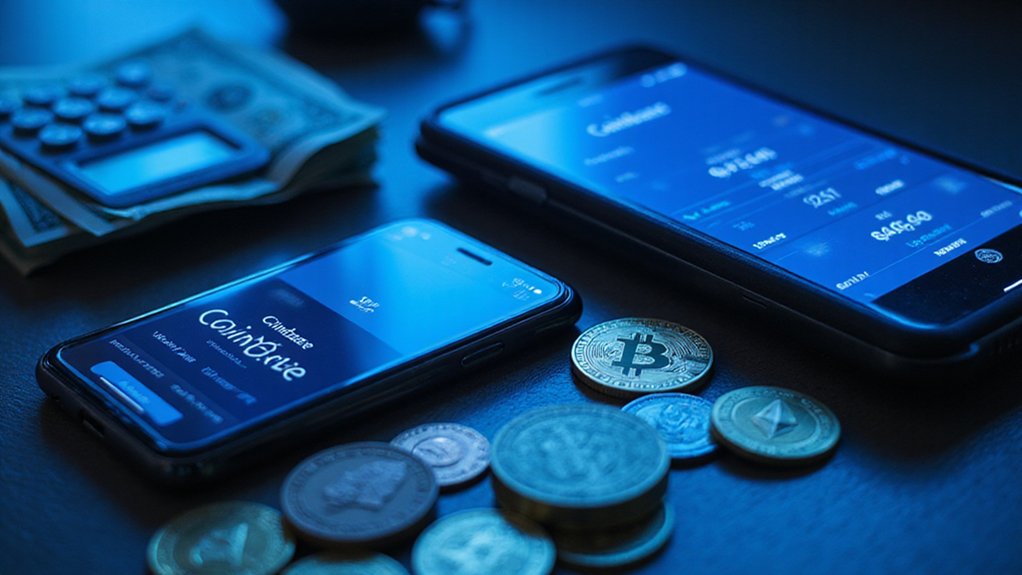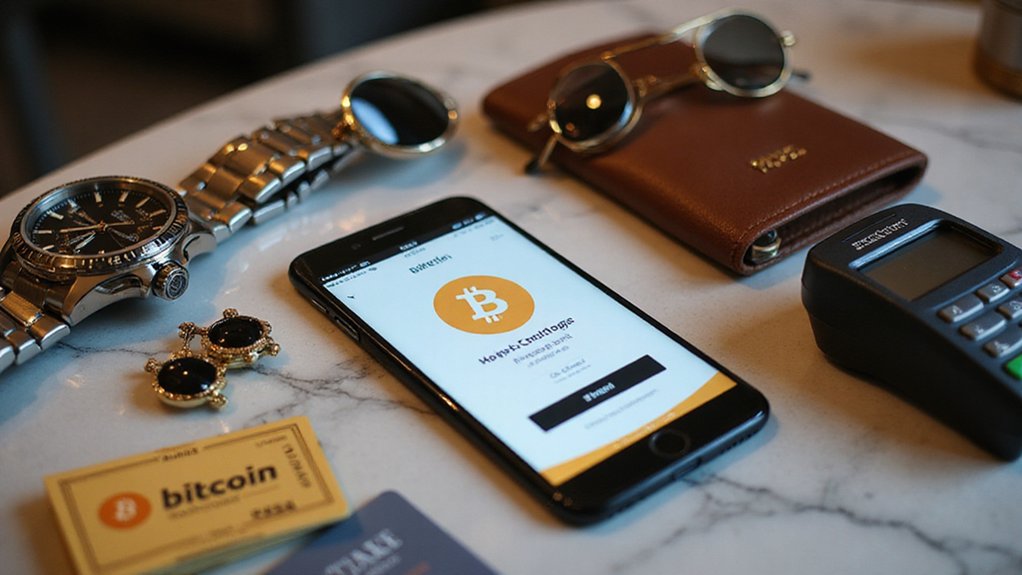Coinbase employs a multi-tiered fee structure that varies substantially by transaction type and volume. Takers face steeper charges (1.20%) than makers (0.60%) for volumes under $1,000, while flat fees ranging from $0.99 to $2.99 apply to smaller purchases. Larger transactions incur variable fees—1.49% for bank transfers and a whopping 3.99% for credit cards. The platform consistently chooses the higher fee option between flat and percentage-based calculations, making thorough fee awareness essential for any profit-minded trader.

How exactly does one navigate the labyrinthine fee structure of America’s most prominent cryptocurrency exchange?
The answer, like most things in the financial world, is simultaneously straightforward and needlessly complex.
Coinbase operates on a tiered system where trading fees begin at 0.60% for makers and 1.20% for takers on modest monthly volumes under $1,000—a structure that rewards those providing market liquidity while extracting a premium from those seeking immediate execution.
The exchange’s fee strategy elegantly rewards market makers while quietly penalizing those who demand instant liquidity.
For the casual crypto dabbler, Coinbase employs a flat fee schedule for transactions below the $200 threshold: $0.99 for purchases up to $10, scaling to $2.99 for amounts between $50 and $200.
This seemingly benign structure belies a potentially expensive reality for frequent traders making multiple small transactions.
The platform’s pricing model reveals its true character once transactions exceed $200, where variable fees take precedence—1.49% for bank transfers (reasonable) and a staggering 3.99% for credit cards or PayPal (highway robbery dressed in convenient clothing).
One must note that Coinbase invariably applies the higher fee between flat and variable options—an approach that maximizes their revenue while minimizing your investment returns.
For merchants utilizing Coinbase Commerce, a comparatively straightforward 1% fee applies to all crypto payments, collected post-transaction in the settlement currency.
When juxtaposed with competitors like Bybit and Binance, Coinbase’s fee structure appears decidedly premium-priced.
The prudent investor might consider these alternatives, particularly as transaction volumes increase.
Unlike Robinhood which employs payment for order flow to offer commission-free trading, Coinbase explicitly charges fees for its cryptocurrency services.
The critical variable remains payment methodology; wire transfers incur a flat $10 fee regardless of transaction magnitude, while debit cards extract nearly four percent of your capital before your investment journey even begins.
In this financial ecosystem, knowledge truly equals profit. Savvy traders often utilize Advanced Mode for trading to access significantly lower fees on maker orders and unlock additional platform features.
Frequently Asked Questions
Can I Negotiate Lower Fees on Coinbase?
Retail users cannot directly negotiate Coinbase’s fee structure, though the platform’s tiered system automatically applies volume-based discounts.
The savvy trader might leverage Advanced Trade for lower rates (0.4% vs. 0.6% base taker fees), employ limit orders to qualify as a maker, or batch transactions to optimize cost efficiency.
For those with considerable capital, institutional accounts through Coinbase Prime potentially access custom pricing—a privilege not extended to the average cryptocurrency enthusiast.
How Do Coinbase Fees Compare to Other Cryptocurrency Exchanges?
Coinbase generally charges premium fees compared to competitors, with basic rates up to 0.60% versus Binance’s 0.10% starting point.
While high-volume traders can access zero maker fees on Coinbase, Binance’s tiered structure (reaching as low as 0.011% with BNB discounts) remains more attractive for most users.
The cost differential reflects Coinbase’s regulatory compliance emphasis and user-friendly interface—essentially, traders pay a convenience premium for the platform’s accessibility and institutional reputation.
Are There Hidden Fees When Withdrawing to External Wallets?
Coinbase doesn’t technically harbor “hidden” fees when withdrawing to external wallets, but their network fee estimation system (which fluctuates with blockchain congestion) occasionally produces surprisingly steep charges.
These variable network fees—particularly during high-traffic periods—can catch users unawares.
Additionally, exchange rate spreads when converting between currencies constitute an implicit cost that many overlook.
Prudent users should review fee schedules before transactions and consider off-peak timing to minimize these predictable yet often unexpected expenses.
Do Coinbase Fees Change During Market Volatility?
During market volatility, Coinbase fees themselves don’t technically change—their published rate card remains static—but the effective cost of trading certainly does.
The platform applies wider spreads during turbulent periods (a rather convenient risk management technique for them), which increases the overall transaction cost.
High-volume traders utilizing Advanced Trade might find some refuge in volume-based discounts, though these hardly offset the spread expansion that accompanies Bitcoin’s more dramatic price gymnastics.
Does Coinbase Pro Offer Better Fee Structures for Beginners?
Coinbase Pro technically offers lower fees than standard Coinbase, but the advantage is negligible for beginners making infrequent or smaller trades.
The platform’s complex interface and advanced trading features create a steeper learning curve that may not justify the marginal fee savings for neophyte investors.
Most beginners find Coinbase’s intuitive interface and straightforward structure worth the premium until their trading volume increases sufficiently to make Pro’s tiered fee structure genuinely advantageous.









